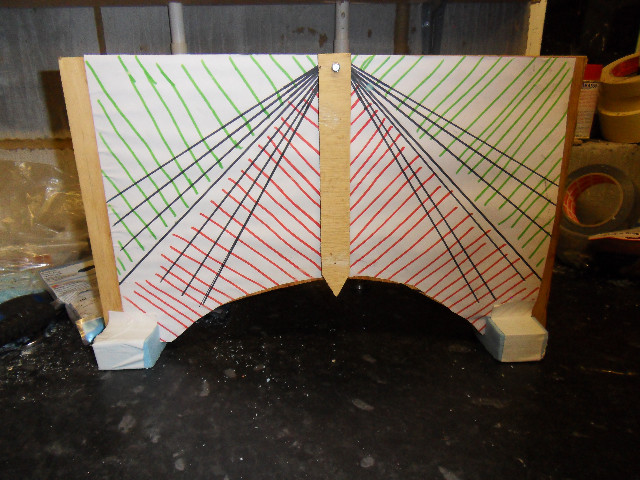The Tilt Test
A tilt test is a good way of checking if a car is roll stable, that is if it will slide before it rolls when turning sharply at speed. It takes into account all of the core variables necessary including: centre of gravity, wheel track and tyre coefficient of friction, in one simple test.
There is some information on a cars roll stability and what a tilt test does on the page CarStability.
This page shows a simple method of carrying out a Tilt Test on a Greenpower car. First the pupils made a simple tilt meter using some 4mm plywood for the surface and pointer, a bolt for a pivot, some paper, some foam for the stands and some blue tack for the pointers weight and to hold the unit on the car during the test. The lines are supposed to be 5 degrees apart (bit of work on protractor skills needed here :) ). The curve at the bottom is to handle cars with round tops. The green area is greater than 45 degrees.
 | |
This simple tilt meter was then used to measure the Tilt Angle of our car. Basic steps were:
- Make sure the car is on a level surface to start with (Meter will show this). Actuallty it doesn't need to be a level surface but the tilt meter needs to be parallel to the cars wheels.
- Place the tilt meter on the car holding in place with two blobs of blue tack making sure it is pointing level (straight down).
- With batteries and driver in the car tilt it to the balance point using the roll-bar. You can easily feel the balance point without letting go. Make sure only one person holds the car in balance.
- Read off the tilt angle. If in the green area it passed (> 45 degrees).
- Will work on the vast majority of cars unless they have sides close to the ground that are well outside of the wheel (such as Brian). In this case maybe a wooden strip with slot for the wheels could be used to hold the wheels further off the ground allowing the car to tilt or a tilting lever would need to be used.
A short video follows showing a Tilt test being performed.
This is an ideal STEM experiment for the pupils. It shows how engineers approach things. When an issue such as a products stability needs to be addressed they would research the science to try and understand the physics of the situation and then model this using mathematics. This will allow them to get a better understanding of the issue and formulate suitable design parameters that address it.
This method works once you have a car to test. However, using the simple mathematics used here, some basic calculations can be done at the car design stage to estimate its tilt angle and hence stability. There is information on how to do this and an on-line calculator on our CarStability page. We used this at the design stage of RR8, it gave a result of 53.28 degrees. We measured the car to be roughly 52 degrees (will do a more accurate test next session) so the on-line calculator appears quite accurate in our case.
For a more accurate measurement a level with angle guage can be used such as the one shown in the picture below or a smart phone with a clinometer app installed could be used.
| | |



